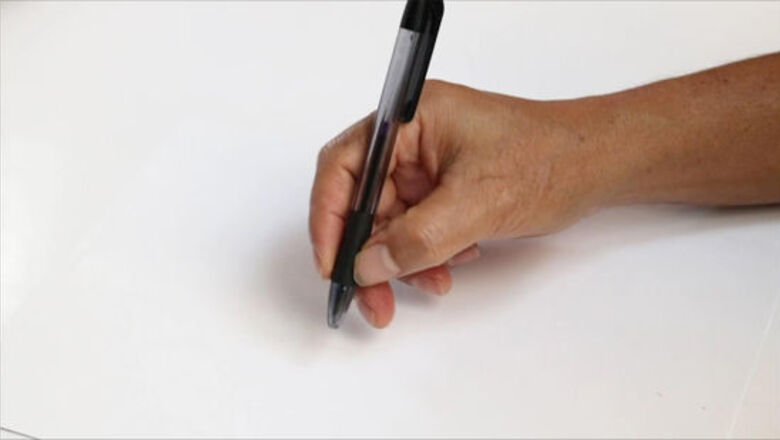
views
Learning the Tripod Grip
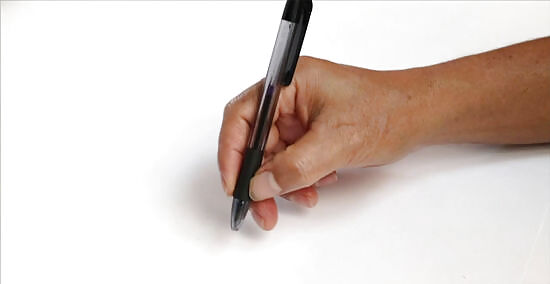
Pick up the pen with your thumb and index finger. The tripod grip uses 3 fingers. Your thumb and your index finger are used to hold the pen in place. Let the back end of the pen rest on the ridge of skin between these fingers. Use your free hand as needed to position the pen in your writing hand. This can be helpful when you are first learning the grip. The tripod grip is the ideal grip to learn, and it will allow you to easily use all sorts of pens.
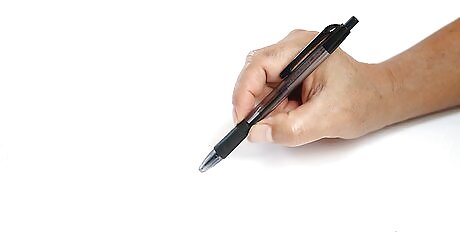
Grip the pen lightly about ⅓ of the way from the tip. No matter which hand you write with, squeeze the pen between your thumb and index finger. Keep your fingers level but on opposite sides of the pen. Hold the pen with a light but firm grip. If you squeeze too tightly, your fingers may tire out or ache after a while. Adjust your grip on the pen as needed until you feel comfortable. You don’t have to place your fingers exactly ⅓ of the way along the pen’s length.
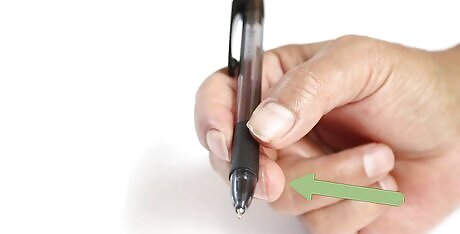
Rest your middle finger on the pen. Bring your middle finger down, underneath the pen. Your middle finger is the third finger to grip the pen, except only the upper half of the tip contacts the pen. Position your ring and pinky fingers underneath your middle finger, not touching the pen. Your middle finger should grip the pen more lightly than your thumb and index finger. Use it to hold the pen still. Make sure the back end of the pen rests against the top part of your hand. Hold the pen at an angle rather than vertically.

Rest the heel of your hand on the page. Move your hand down like you’re going to start writing. Set the back edge, which is the part right above your wrist, on the paper. Let your ring and pinky fingers rest on the page as well. Adjust your hand until you feel comfortable enough to write. The pen should be at an angle, enough so that you can press the tip to the page. Your wrist may rise slightly to allow you to move the pen. Avoid lifting it too much, since that can end up causing cramps due to to tension. If your hand comes up off the page, you may be gripping the pen too hard.
Using the Quadropod Grip
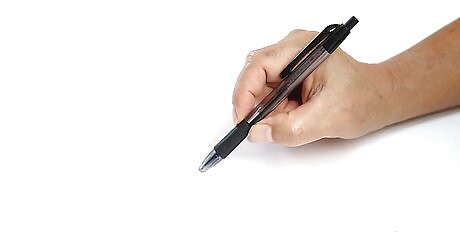
Position the pen between your thumb and index finger. The quadropod grip is very similar to the tripod grip. The pen will still rest against your hand, between your thumb and index finger. Start by using your 2 main fingers to hold onto the pen and control it. The quadropod grip is less common than the tripod grip, but if it feels natural to you, you can continue using it.
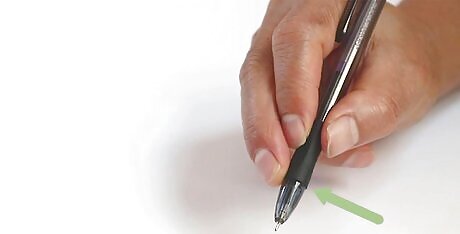
Grip the pen with your middle finger about ⅓ of the way from the tip. Squeeze the pen between your thumb and index finger close to the pen’s tip. Bring your middle finger down, planting it squarely on the pen. Like with your index finger and thumb, your middle finger is used to control the pen. Keep a firm, even grip with all 3 fingers. You may need to adjust your grip a little. Move your fingers until you feel comfortable. Make sure all 3 of your fingers maintain a light but firm grip on the pen.
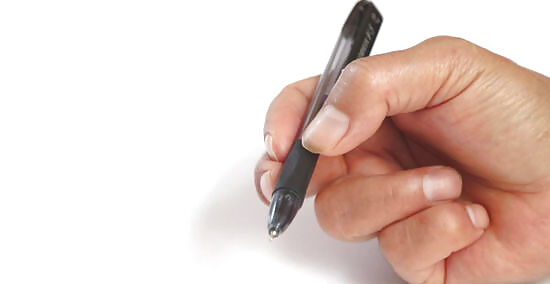
Rest the pen on your ring finger. Slide your ring finger underneath the pen. Your ring finger should be right below your middle finger. Grip the pen with the top half of your fingertip. Hold the pen lightly with this finger. Your hand may look slightly claw like in this position. Bend your fingers only slightly so you are able to maintain control of the pen. If your fingers are bent uncomfortably, hold the pen closer to the tip.
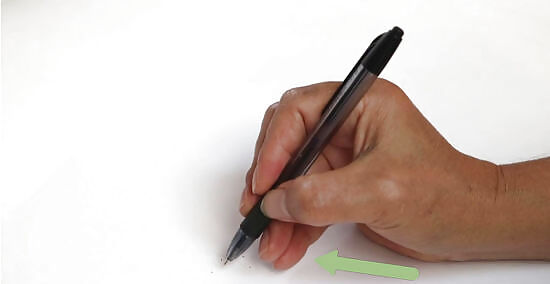
Rest the heel of your hand on the page. Tuck your pinky finger underneath your ring finger as you move your hand towards the page. Use the bottom edge of your hand and pinky finger to support your hand as you write. The pen should be at an angle with only the tip touching the page. Loosen your grip if your hand comes up off the page. Avoid holding the pen straight up in the air. Keep it at a gentle angle to avoid wearing out your fingers.
Improving Your Grip
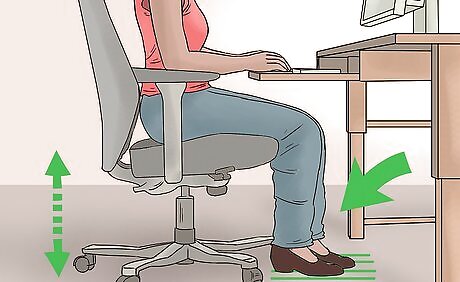
Sit up straight with your feet on the floor. Having good posture is important for both improving your posture and avoiding injuries. Sit in a chair with a firm back rather than a cushy recliner. Plant your feet firmly on the floor. Sit up so you can peer over the paper, but don’t hunch over it. If your posture is bad, you may end up holding your pen improperly, so be sure to practice good posture whenever you can. Feeling comfortable while writing is the most important part. You should also feel like your arms have a free range of movement. If you maintain bad posture, you may begin to notice stiffness in your back. Your arms may also tire out quickly as you write.

Loosen your grip to avoid finger pain. You may be tempted to curl your fingers over the pen, pressing so tightly that your fingers begin cramping. You do not have to press so hard that your knuckles turn white and your pen rips the paper. Position your fingers close to the pen’s tip, holding on firmly but gently. If your hand looks like a claw or a fist, you are likely holding the pen too tightly. Straighten your fingers, letting the pen rest on your hand. To practice your grip, place a small object, such as a tissue, rubber ball, or coin, in your hand. Holding an object in your writing hand ensures your hand stays more open, keeping your grip loose.

Use your arm and shoulders to move the pen. Most people write with their fingers. They hold their arms completely stiff and use their fingers to control the pen. Instead of doing this, try keeping your fingers still and moving your arms and shoulders. You may find that your grip on the pen relaxes as you practice. Writing this way engages muscles in your forearm, which are larger and less prone to tiring out than your fingers. Using your arms and shoulders can feel awkward at first, especially if you are used to writing with your fingers.
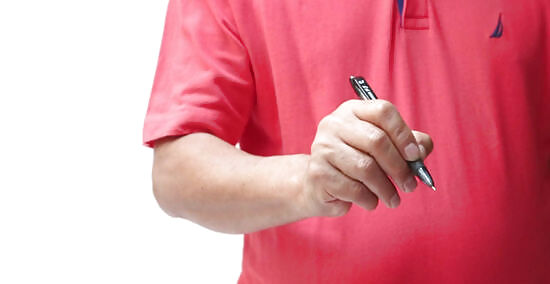
Practice writing in the air to increase your mobility. No paper needs to be wasted to write invisible words in the air. Hold the pen with your desired grip, then raise your arm straight up in the air. Move your arm like you are writing out sentences. Since you aren’t confined to a desk and paper, you likely will feel free to relax your grip and move about more. This is the perfect way to practice utilizing your arms and shoulders, but it is also helpful for developing your grip.
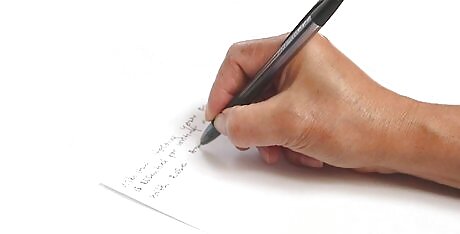
Practice writing sentences on paper. Set a piece of paper on a flat surface, such as your desk. Hold the pen in a way that feels comfortable to you, then start writing. You can write out any words that come to mind. Try to write full paragraphs, working from 1 side of the page to the other. Start out writing slowly. Once you feel comfortable holding and moving your pen, you can begin writing more quickly. Practicing can also help you refine your writing so it is neater. Practice makes perfect!



















Comments
0 comment